Physical Address
304 North Cardinal St.
Dorchester Center, MA 02124
Physical Address
304 North Cardinal St.
Dorchester Center, MA 02124
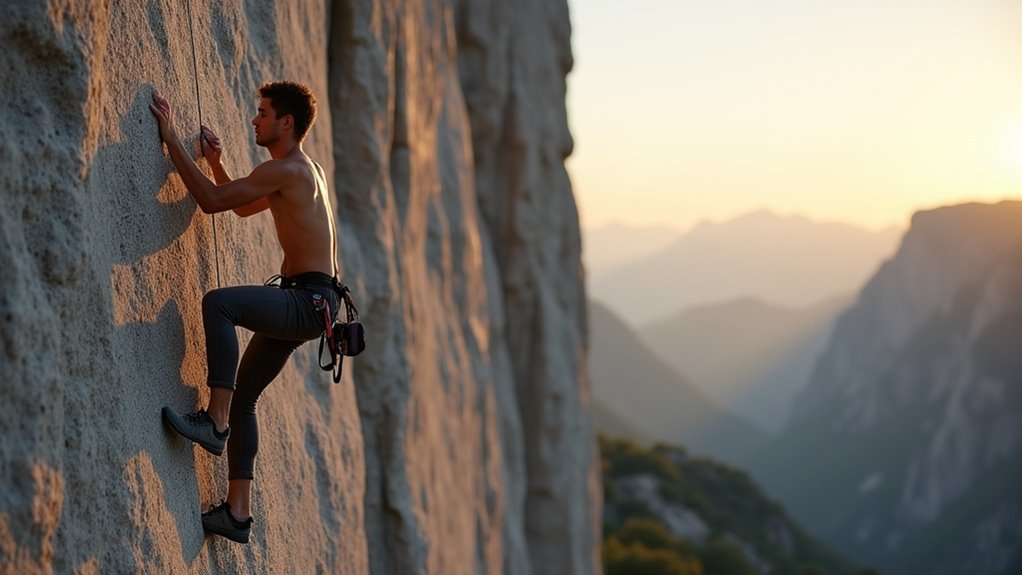
Most climbers unknowingly repeat dangerous mistakes that could end their climbing career—discover which critical errors you're probably making.
Did you know that 70% of climbing accidents stem from preventable human errors rather than equipment failure? Whether you’re a weekend warrior or seasoned climber, you’re likely making at least a few critical mistakes that could compromise your safety and progress. These common oversights range from poor belaying techniques to skipping essential gear checks, and they’re happening on crags and gym walls everywhere. Understanding these pitfalls could be the difference between a successful climb and a dangerous situation.
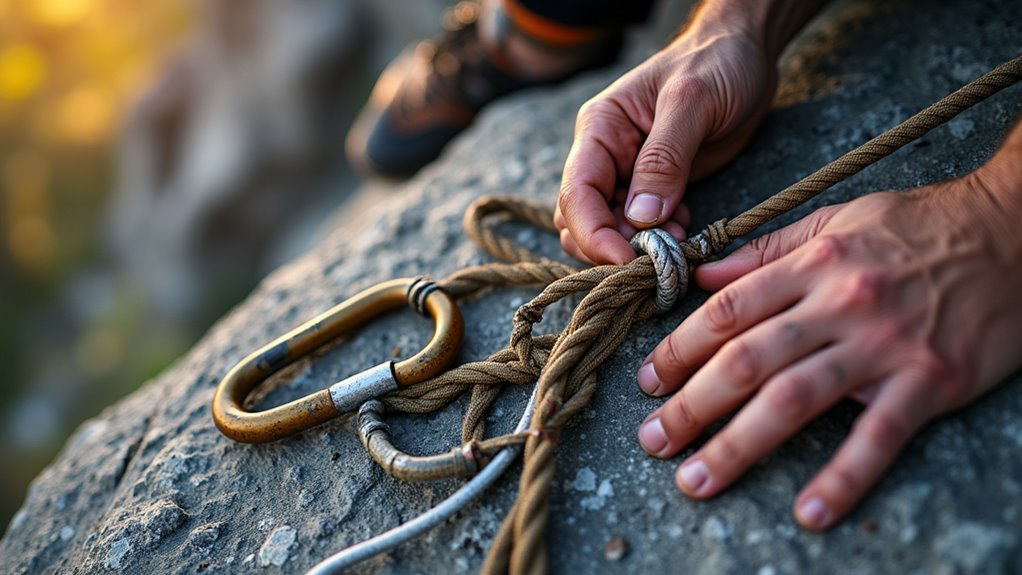
While you might feel enthusiastic to start your ascent, skipping a thorough gear inspection is one of the most dangerous shortcuts you can take in rock climbing. Your life depends on equipment that’s working perfectly, so don’t rush this critical step.
Check your harness for frayed webbing, worn stitching, or damaged buckles. Inspect carabiners for gate function and look for hairline cracks or excessive wear.
Examine your rope for cuts, flat spots, or core damage by running it through your hands completely. Test your belay device’s moving parts and verify proper function.
Create a pre-climb checklist and stick to it religiously. Replace any questionable gear immediately – it’s cheaper than hospital bills. Remember, gear failure isn’t always obvious until it’s too late.
Just as church camp experiences teach the importance of thorough preparation and safety protocols for meaningful activities, developing disciplined gear inspection habits will serve you well throughout your climbing journey.
Because your climbing partner’s safety rests entirely in your hands, mastering proper belaying techniques isn’t optional – it’s essential. Many climbers develop sloppy habits like keeping their brake hand too loose or getting distracted while belaying. You must maintain constant control of the brake strand and never let go completely.
Communication breakdowns cause serious accidents. Establish clear commands before climbing: “On belay,” “Climbing,” “Take,” and “Lower me.” Don’t assume your partner understands mixed signals or unclear shouts. Speak loudly and wait for confirmation.
Watch for common errors like feeding rope too quickly during leads or taking someone off belay prematurely. Stay focused on your climber’s position and anticipate their needs. Practice belaying techniques regularly, and never belay while distracted by conversations or phones. Just as outdoor enthusiasts rely on a camping GPS to navigate safely through unfamiliar terrain, climbers need reliable communication and navigation tools to ensure they can find their way back to base camp or communicate their location in case of emergency.
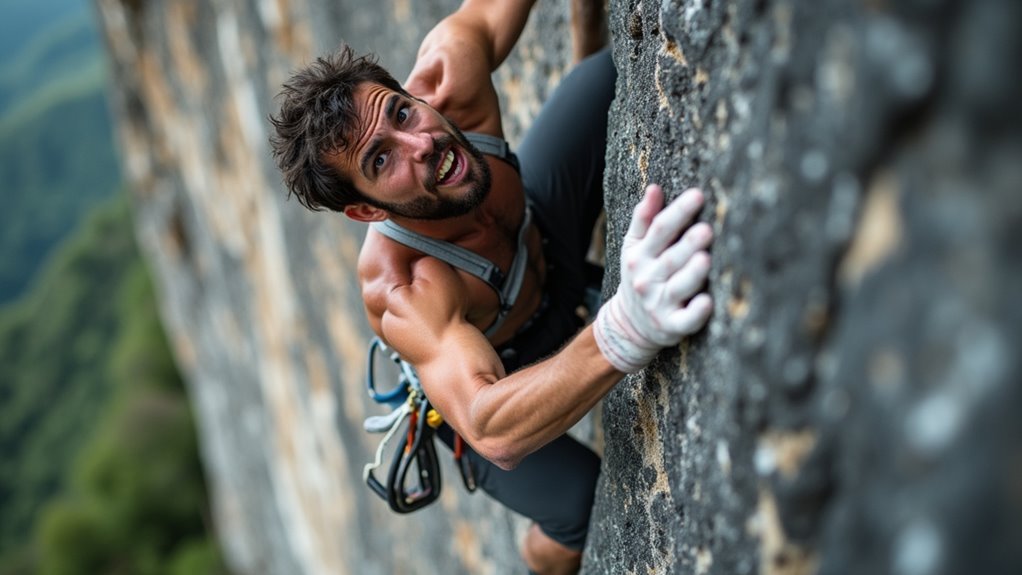
Although the adrenaline rush of tackling harder routes feels incredible, pushing yourself too far beyond your abilities creates dangerous situations you’re not equipped to handle. Your technique suffers when you’re desperately clinging to holds, making falls more likely and potentially dangerous.
You’ll develop bad habits like over-gripping, poor footwork, and panic responses.
Progress systematically instead. Master your current grade completely before advancing. Can you climb multiple routes at your level cleanly and confidently? If not, you’re not ready for harder climbs.
Focus on technique refinement, endurance building, and mental preparation. Always carry essential first aid supplies when climbing outdoors, as injuries from overreaching your abilities can occur far from immediate medical help.
When you skip warming up before climbing or rush off the wall without cooling down, you’re setting yourself up for injury and limiting your performance potential. Your muscles, tendons, and joints need preparation before tackling challenging routes.
Start with light cardio, dynamic stretches, and easy climbs to gradually increase blood flow and flexibility.
Many climbers jump straight onto difficult problems, leading to pulled muscles or tweaked fingers. A proper warm-up takes 10-15 minutes but prevents weeks of recovery time.
Similarly, cooling down helps your body transition back to rest mode and reduces muscle soreness.
Don’t treat warm-ups as optional—they’re essential preparation. Your body will thank you with better performance, fewer injuries, and longer climbing sessions throughout your climbing career.
For quality climbing gear to support your warm-up routines and climbing sessions, consider shopping at award-winning retailers that specialize in outdoor equipment and understand climbers’ needs.
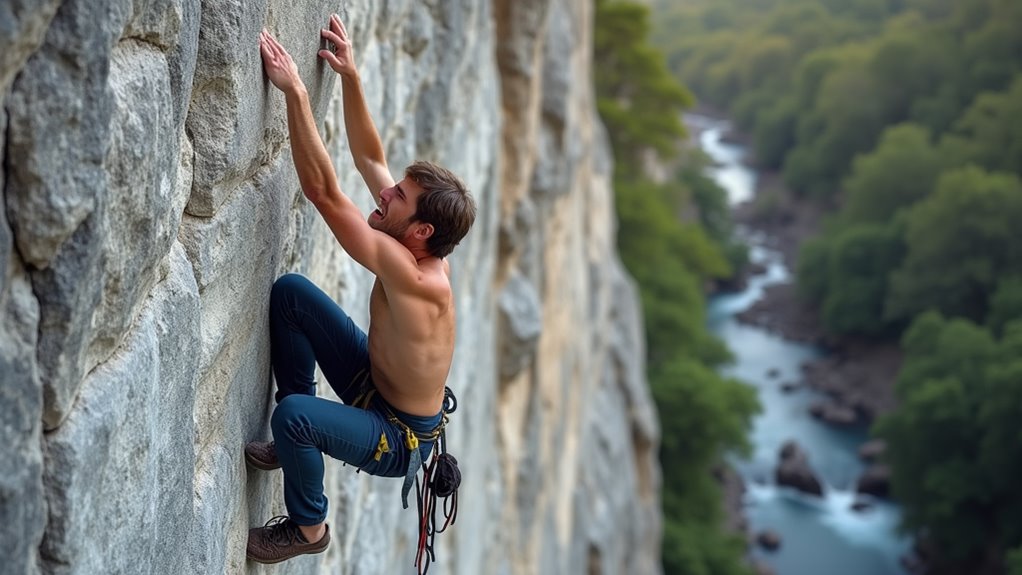
While your muscles might feel ready after a proper warm-up, you’ll still struggle on routes if your body positioning is off.
Many climbers rely too heavily on arm strength instead of using their legs effectively. You’re wasting energy when you don’t keep your hips close to the wall or fail to shift your weight properly between holds.
Watch experienced climbers—they move with fluid precision, positioning their bodies to maximize efficiency. Practice flagging, stemming, and mantling techniques.
Keep your arms straight when possible to reduce fatigue, and use your legs to push rather than just pulling with your arms.
Focus on smooth, deliberate movements instead of frantic scrambling. Your center of gravity should flow naturally from hold to hold, making climbing feel less strenuous and more controlled.
Developing proper technique becomes even more crucial when you’re rock climbing during camping trips where access to coaching or immediate help may be limited.
Even if you’ve mastered your technique, you’re putting yourself at serious risk by overlooking weather conditions and environmental dangers. Check weather forecasts before heading out – sudden storms can create lightning hazards and make rock surfaces dangerously slippery. Don’t climb on wet rock, as it’s both unsafe and damages the stone.
Watch for loose rock that can break away unexpectedly, especially after rain or freeze-thaw cycles. Be aware of wildlife like snakes or aggressive birds protecting nests. Rockfall zones are particularly dangerous during temperature changes when ice melts or expands.
Always inform someone of your climbing plans and expected return time. Carry emergency supplies including first aid, headlamp, and extra layers. Environmental awareness isn’t optional – it’s essential for safe climbing. By improving your climbing efficiency through proper preparation and risk assessment, you’ll spend more energy on the actual climb rather than dealing with preventable hazards.
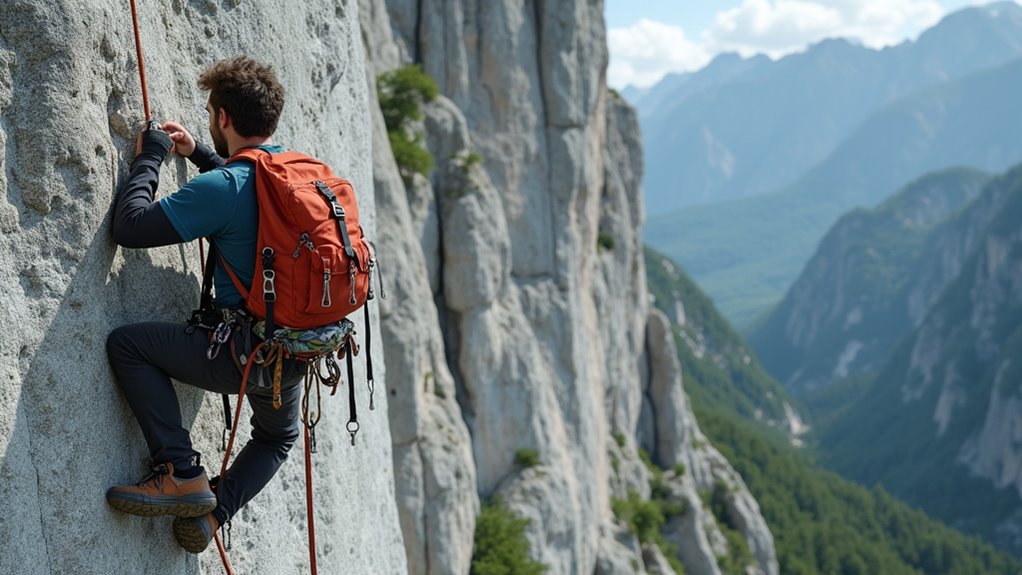
Beyond environmental awareness, you need to thoroughly research your chosen route before you clip into your harness. Inadequate planning leads to dangerous situations that could’ve been avoided with proper preparation.
Here’s what you should research beforehand:
Don’t rely solely on guidebook descriptions from years ago. Conditions change, holds break, and new hazards develop.
Contact local climbing shops or experienced climbers for updated route intelligence.
If your climbing adventure involves outdoor camping, ensure you pack essential mosquito-repellent gear to protect yourself from insects during overnight stays at the crag.
After you’ve planned your route, the most critical skill between you and the ground becomes your knot tying and rope management. You can’t afford sloppy habits here—your life literally depends on getting it right every time.
Double-check your figure-eight follow-through before leaving the ground. Many accidents happen because climbers rush this fundamental step or fail to dress the knot properly. Practice tying knots until muscle memory takes over, especially in cold or stressful conditions.
Practice your knots until they become second nature—when conditions get tough, muscle memory could save your life.
Keep your rope organized and free from tangles. Flake it properly at the base, and communicate clearly with your belayer about rope commands. Don’t step on the rope or let it drag across sharp edges.
Store ropes away from chemicals and UV exposure to maintain their integrity. Just like other outdoor activities, proper equipment preparation beforehand can prevent many safety issues from occurring during your climb.
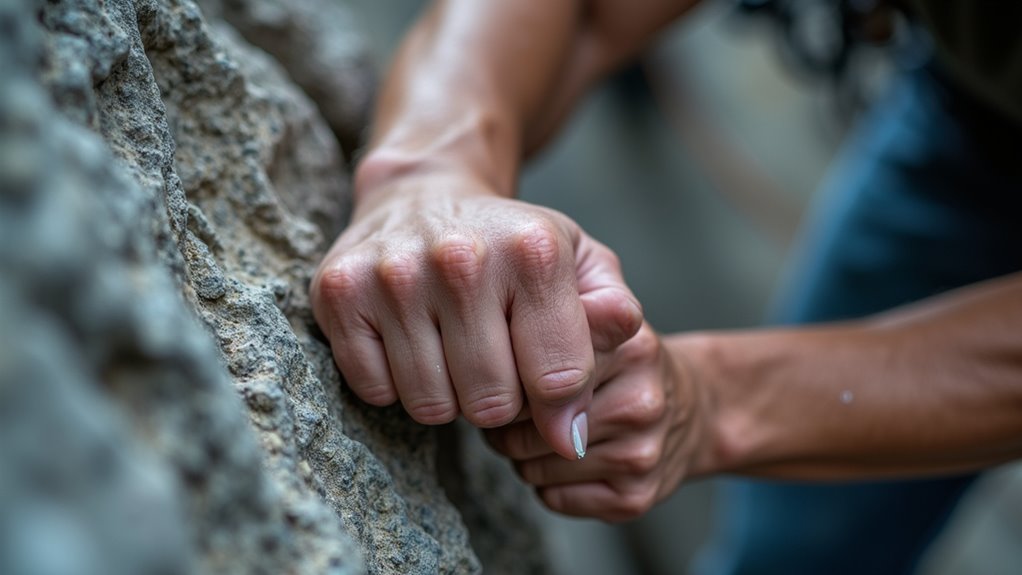
While proper knots keep you safe, inefficient movement patterns will drain your strength long before you reach the top. You’re likely gripping holds like your life depends on maximum squeeze when you only need enough pressure to maintain contact. This overgripping creates unnecessary tension throughout your entire body, burning through energy reserves.
Here’s how to climb more efficiently:
Practice conscious relaxation between moves to conserve energy for challenging sections. Just as choosing eco-friendly sleeping bags helps preserve nature for future climbing adventures, developing efficient movement patterns preserves your energy for longer, more sustainable climbs.
Even when you’ve mastered efficient movement, fear of falling will sabotage your climbing progress if you haven’t learned to trust your gear and practice controlled falls. You’ll pump out faster when scared, grip holds too tightly, and avoid moves you’re capable of making.
Start by taking practice falls in a controlled environment. Begin with small whips on solid gear, gradually increasing the distance as your confidence grows. Learn proper falling technique: keep your feet wide, stay relaxed, and don’t grab the rope. Your belayer should practice giving soft catches too.
Trust develops through experience and knowledge. Check your gear placements, understand load limits, and inspect equipment regularly. The more you fall safely, the more you’ll push your limits and improve your climbing performance.
Just as senior campers can enjoy outdoor adventures with proper preparation and confidence-building, rock climbers of all ages benefit from gradually developing trust in their equipment through systematic practice.
You’ve learned about climbing’s costliest catastrophes and most menacing mistakes. Don’t let dangerous decisions derail your development—instead, focus on fundamental fixes that’ll fortify your foundation. Practice proper procedures, perfect your positioning, and prioritize preparation over pushing limits. Remember, rock climbing’s rewards require respect for risks and relentless attention to details. By building better habits and banishing bad behaviors, you’ll climb confidently while keeping catastrophe at bay. Stay safe, stay smart, and keep scaling those stunning summits.